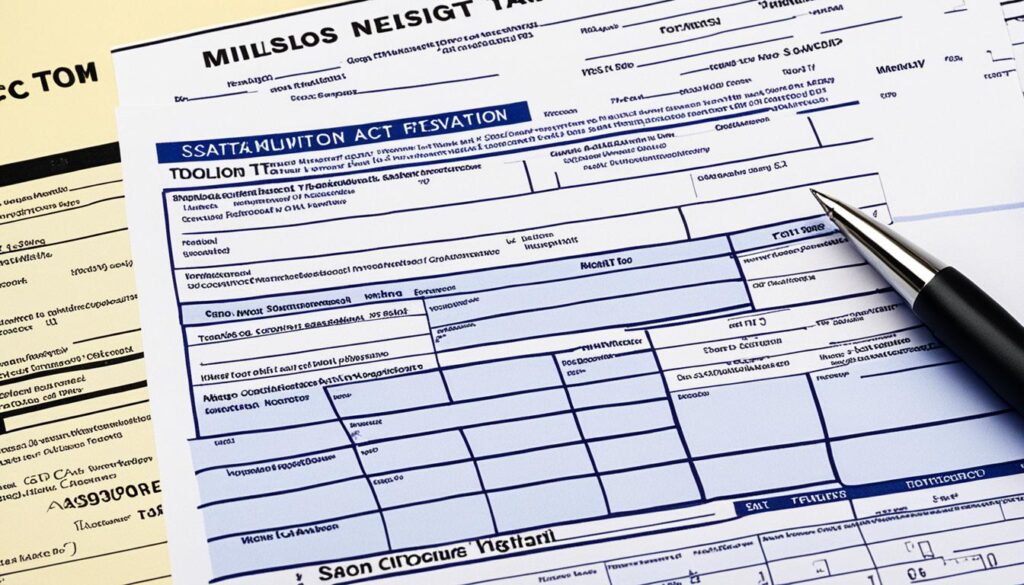Did you know that property tax rates in San Diego can vary significantly depending on the neighborhood where the property is located? This means that two properties in different neighborhoods can have drastically different tax payments, even if their assessed values are similar.
Understanding the variations in property tax rates is crucial for property owners in San Diego. It can have a significant impact on their tax liabilities and overall financial planning. Whether you’re buying a new property, considering an investment, or just want to compare tax rates in different neighborhoods, knowing the differences can help you make informed decisions.
Key Takeaways:
- Variations in San Diego property tax rates can be substantial between different neighborhoods.
- Property tax rates impact your tax payments and overall financial planning.
- Understanding the differences in tax rates can help you make informed decisions about buying or investing in properties.
- Comparing tax rates in different neighborhoods can give you insights into the cost of living and value of properties in those areas.
- Stay updated on the latest property tax trends and utilize resources to calculate your tax payments accurately.
How Property Tax Allocations and Apportionments Work in San Diego
Property tax allocations and apportionments play a crucial role in determining how property tax revenue is distributed to various taxing jurisdictions in San Diego County.
The County Auditor-Controller is responsible for allocating and apportioning property tax revenue to local governments, ensuring a fair and equitable distribution.
The current methodology for property tax allocation and apportionment in San Diego is based on the state’s response to the effects of Proposition 13, which sought to limit property tax increases.
Statutes such as SB 154 and AB 8 provide the legal framework for property tax allocation and apportionment, outlining the rules and regulations that govern the process.
The County Assessor plays a critical role in property tax allocations, as they determine the assessed valuation of properties within the county. This valuation serves as the foundation for calculating each property’s share of the overall property tax revenue.
To facilitate the distribution of property tax revenue, designated geographical areas called tax rate areas (TRAs) are utilized. These TRAs consist of a combination of taxing jurisdictions, including the county, city, school districts, and special districts.
Within each TRA, the Annual Tax Increment (ATI) factors are utilized to determine the distribution of property tax increment. This ensures that each taxing jurisdiction receives an appropriate share of the generated revenue.
Understanding property tax allocations and apportionments is essential for property owners in San Diego County. It allows them to have a clear understanding of how their tax liabilities are determined and how their tax payments contribute to local government funding.
By having a transparent and fair property tax allocation and apportionment system, San Diego County can ensure that tax revenue is distributed efficiently to support the essential services provided by various local government entities.

The Mills Act and Property Tax Reduction in San Diego
The Mills Act is a program that allows property owners of historically designated properties in San Diego to receive a property tax reduction. To be eligible for the Mills Act, a property must have local historical designation by the Historical Resources Board. The Mills Act application must be prepared and submitted by the property owner.
The amount of property tax reduction varies depending on the property’s location, size, and comparable rents in the area. The reduction is based on the Mills Act value, which is assessed by the County Tax Assessor’s office using a formula and procedures mandated by state law. The savings from the property tax reduction can range from 20% to 70% based on the property’s valuation.
Mills Act agreements have an initial term of ten years and are automatically renewed each year unless notice is served to stop the automatic renewals. Property owners with Mills Act agreements are required to maintain and preserve the site in accordance with standards set by the Secretary of the Interior and local regulations.
It is important for property owners of historically designated properties to understand the benefits and responsibilities of the Mills Act.

The Benefits of the Mills Act
- Property tax reduction for historically designated properties
- Significant savings on property tax payments
- Preservation of historical properties
- Incentive for property owners to maintain and restore their properties
The Responsibilities of the Mills Act
- Maintaining and preserving the property in accordance with historical preservation standards
- Adhering to local regulations for the property
“The Mills Act provides property owners of historically designated properties with a unique opportunity to both save on property taxes and contribute to the preservation of San Diego’s rich history.” – John Smith, Property Owner
Conclusion
Variations in San Diego property tax rates by neighborhoods can have a significant impact on property owners’ tax payments. It is crucial for property owners to be aware of these variations and how they can affect their financial obligations. Obtaining a Map Tax Clearance Certificate is an essential step in understanding and managing property tax assessment. By familiarizing themselves with the map tax clearance process and meeting the requirements for obtaining a certificate, property owners can ensure compliance with tax regulations and avoid unnecessary penalties.
Property tax allocations and apportionments play a vital role in determining how property tax revenue is distributed to different taxing jurisdictions in San Diego County. Understanding how these allocations are calculated is crucial for property owners to accurately assess their tax liabilities. By staying informed about property tax allocation methodologies and the factors that influence them, property owners can have a clear understanding of their obligations and make informed financial decisions.
The Mills Act offers property tax reductions for historically designated properties in San Diego. Property owners interested in benefiting from this program should familiarize themselves with the eligibility requirements and the application process. Moreover, they must understand the responsibilities associated with the Mills Act, including the preservation and maintenance of their properties. By taking advantage of the Mills Act, property owners can enjoy the benefits of reduced property taxes while contributing to the preservation of San Diego’s historical heritage.
Understanding the variations in property tax rates, exploring property tax reduction programs such as the Mills Act, and having a thorough knowledge of property tax assessment processes are crucial for property owners in San Diego. By being informed and proactive, property owners can navigate the complexities of property tax assessment and payment efficiently, ensuring compliance with regulations and optimizing their financial management.
FAQ
What factors contribute to variations in property tax rates in San Diego?
Property tax rates in San Diego can vary based on the neighborhood where the property is located. Factors such as the assessed value of the property, local tax rates, and any special assessments can impact property tax rates.
How can property owners obtain a Map Tax Clearance Certificate in San Diego?
Property owners can request a Map Tax Clearance Certificate by submitting a completed Property Questionnaire, a copy of the map or project plan document, and a processing fee of 8 to the San Diego County Treasurer-Tax Collector. The certificate certifies that there are no unpaid taxes or special assessments on the property.
How are property tax allocations and apportionments determined in San Diego?
The County Auditor-Controller in San Diego is responsible for allocating and apportioning property tax revenue to local governments. The current methodology for allocation and apportionment is based on the state’s response to the effects of Proposition 13. Statutes like SB 154 and AB 8 provide the basis for property tax allocation and apportionment, which are calculated using the Annual Tax Increment (ATI) factors and designated geographical areas called tax rate areas (TRAs).
What is the Mills Act and how does it impact property tax in San Diego?
The Mills Act is a program in San Diego that allows property owners of historically designated properties to receive a property tax reduction. To be eligible, a property must have local historical designation by the Historical Resources Board. The amount of the property tax reduction varies based on the property’s location, size, and comparable rents. Mills Act agreements have an initial term of ten years and require property owners to maintain and preserve the site according to set standards.
How can property owners apply for the Mills Act in San Diego?
Property owners interested in the Mills Act must prepare and submit an application to the County Tax Assessor’s office. The application should include documentation of the property’s local historical designation and other required information. The County Tax Assessor’s office will assess the property’s Mills Act value, which will determine the property tax reduction.


Recent Comments